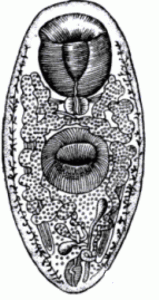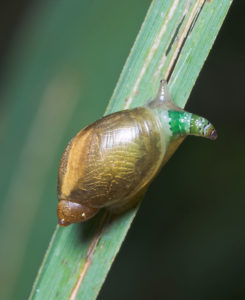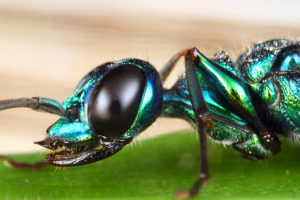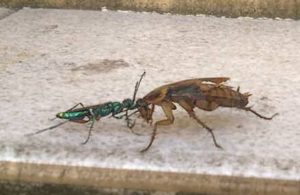That long-ago encounter with the Cordyceps fungus (described in Part 1 of this series) spurred my interest in determining whether other, similar mind-controlling parasites exist. Not surprisingly, they do. I find such symbiotic interactions between parasite and host to be both fascinating in their intricacy and disturbing in their manifestations.
For example, there is Leucochloridium. This parasite is a fluke, a type of flatworm. Although many flatworms are free-living, the group also contains a plethora of species which have evolutionarily opted for the parasitic way of life. All of the vertebrates, including mammals and birds, are subject to parasitism by some kind of fluke. In the case at hand, it is the alteration of the host’s behavior that makes Leucochloridium yet another fascinating example of the bizarre and creepy world of the endoparasites.
 Leucochloridium parasitizes birds. The big problem faced by Leucochloridium, and parasites in general, is how to get from one host to another. Endoparasites are highly and specifically adapted for surviving in the warm, dark, nutrient rich innards of their host. They are not built to function in what for them is the hostile outer world we humans inhabit. Here the atmosphere is highly oxygenated, there is intense sunlight, and ambient temperatures are highly variable. Yet, to continue their species, they must find a way to insinuate their adult progeny into the internal organs of another host.
Leucochloridium parasitizes birds. The big problem faced by Leucochloridium, and parasites in general, is how to get from one host to another. Endoparasites are highly and specifically adapted for surviving in the warm, dark, nutrient rich innards of their host. They are not built to function in what for them is the hostile outer world we humans inhabit. Here the atmosphere is highly oxygenated, there is intense sunlight, and ambient temperatures are highly variable. Yet, to continue their species, they must find a way to insinuate their adult progeny into the internal organs of another host.
We must now ask, how does a flatworm (Leucochloridium) which lives in the rectum of a bird ensure that its descendants find a similar warm, fecal-laden home in a different bird? As with many endoparasites, the answer lies in the use of an intermediate host animal within which the larval stages go through their transitional, developmental steps. Flukes commonly use snails as intermediate hosts and Leucochloridium is no exception.
The life cycle begins as the adult flatworm voids its eggs into the surrounding rectum of its bird host. The intestinal wastes of the bird are thus loaded with the fluke’s eggs. A foraging snail, the intermediate host of the flatworm, happens upon the bird feces and begins to feed. The eggs are coincidentally ingested with the fecal material. Subsequently they hatch and go through a series of developmental stages. Having reached a phase at which they are ready to infect another bird, the fluke larvae perform a most interesting migration. Called cercariae at this stage, the larvae migrate through the snail’s body and into the tentacles on the head. You might be familiar with these as the long stalks at the end of which are located the snail’s eyes. As a result of infiltration by the larvae, the tentacles (or often one tentacle) become engorged and distended. Even more remarkably, they appear to pulsate like a neon sign in response to exposure to light (https://www.youtube.com/watch?v=v0Ytm2U4Ch0). For birds, this  banded, animated appearance bears a remarkable resemblance to a caterpillar. Of course caterpillars are a favorite food of many bird species. And remember, these puffed-up tentacles are packed with fluke larvae very much needing to get into a bird.
banded, animated appearance bears a remarkable resemblance to a caterpillar. Of course caterpillars are a favorite food of many bird species. And remember, these puffed-up tentacles are packed with fluke larvae very much needing to get into a bird.
And now the curious issue of parasitic mind control again enters the equation. Snails normally prefer dark habitats. Here the air is more humid which helps to prevent dehydration of their moist molluscan body. The dark niches of their world also offer protection from predators seeking a nice meal of escargot. But snails infected by Leucochloridium shun the dark, hidden places. They boldly venture out into the daylight. Goaded by biochemical signals from the parasite, they become even more incautious and climb up onto grasses and trees thus making themselves even more conspicuous. Perched here in the broad daylight, with their pulsating, caterpillar-like tentacles the snails are attractive targets for birds. Perceiving what it thinks is a caterpillar, a bird will swoop down and attack the snail’s infected tentacle. In the process, it comes away not with a young insect but a nice package of fluke larvae. These move on into the bird’s digestive tract and, voila, the life cycle of the fluke is completed. Again, the thing that strikes me as so uncanny is the manner in which the parasite changes the behavior of its host. The hapless snail which, under normal conditions, eschews the light and the dry air suddenly behaves in exactly the opposite manner. And, as a result, the parasite’s life cycle needs are brought to a perfect ending. How weird! This would be a campfire tale guaranteed to keep little snails up all night.
How about one more example of the strange world of parasitic mind control? Although it uses venom as a rather more straightforward method for controlling its host, the life cycle of the little emerald cockroach wasp is still a marvel of evolution. As the name suggests, this is a small (a bit less  than an inch) wasp with a beautiful metallic greenish-bluish body color. And, it does indeed parasitize cockroaches. As you might guess, it is the manner in which it does so that is dumbfounding.
than an inch) wasp with a beautiful metallic greenish-bluish body color. And, it does indeed parasitize cockroaches. As you might guess, it is the manner in which it does so that is dumbfounding.
Upon locating a cockroach the female wasp stings it. Surprisingly (and precisely) she does so twice. The first sting is administered into the abdomen at the exact point necessary to paralyze the cockroach’s two front legs. Now the wasp is able to work around the roach’s head without any counterattack from these appendages. Again bringing her sting to bear, the wasp injects her venom into the portion of the cockroach’s nervous system called the subesophageal ganglion, a sort of insect sub-brain. The result of this sting is that the roach loses its will to escape. Although capable of movement, the hapless victim behaves like some arthropod robot and passively waits for the wasp to continue its ghastly work. Now, taking hold of one of the cockroach’s  antennae with its jaws, the wasp leads its host to a previously prepared burrow in the ground. Like a well-trained dog on a lead, the cockroach obediently allows itself to be ushered, by the wasp, down into its own tomb.
antennae with its jaws, the wasp leads its host to a previously prepared burrow in the ground. Like a well-trained dog on a lead, the cockroach obediently allows itself to be ushered, by the wasp, down into its own tomb.
Having arrived in the burrow, the wasp proceeds to lay a single egg on the abdomen of the amazingly cooperative cockroach. Still the roach shows no inclination to flee. The wasp now clambers out of the burrow and backfills it with soil or small pebbles. In a few days, the wasp’s larva emerges from the egg. As with other hymenopterans, the larva resembles a fly maggot. This larva now begins to feed on the ill-fated cockroach and, in so doing, gradually moves into the cockroach’s abdominal cavity. Incidentally, recent research has shown that the larvae of this wasp secrete antibiotic laden saliva which kills bacteria harbored within the cockroach’s body. These are bacteria which might be harmful to the grub. Could this be yet another biological source of antibiotic for human use? Time will tell.
After several days of feasting, the wasp larva forms a pupa inside the cockroach’s body. From here, it soon emerges as an adult wasp. Sounds like something out of a science fiction movie. Anyone else thinking of Ridley Scott’s Alien trilogy? It seems that, in this case, the wasp is using its toxin to block certain insect neurological pathways. Although perhaps less biochemically complicated than the mind altering mechanisms of Cordyceps or Leucochloridium, we still must marvel at the complexity and efficiency of this diminutive wasp’s behavioral repertoire.
One might presume to meditate upon the fact that it is a really good thing that humans don’t fall prey to such insidious parasitic mind control. Of course, in making such a presumption, we would likely be kidding ourselves. We must recognize that humans are biological organisms too – undeniably solid citizens of good-standing within the Kingdom Animalia. As a result, we should be considerably more surprised if we were not considered fair game by such parasites. In fact, research suggests very strongly that humans are far from immune to the mind-bending antics of parasites.
For a glimpse into the disconcertingly disturbing world of parasitic mind control in humans, be sure to keep an eye out for The Stealth Attack – Part 3.
Photo Credits:
Leucochloridium graphic - Intro.to Parasitology by Chandler and Read
Leucochloridium infected snail - Thomas Hahmann at Wikimedia Commons
Emerald Cockroach Wasp - courtesy of bioweb.uwlax.edu
Wasp with Cockroach - courtesy of creativecommons.com
